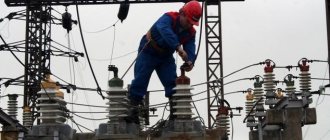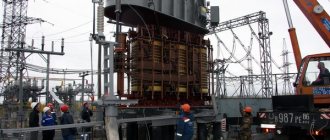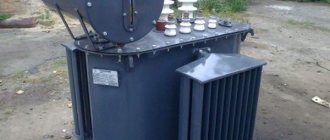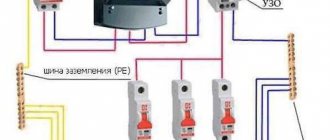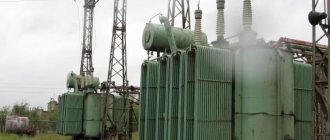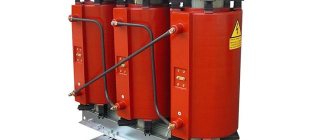Author: Evgeny Zhivoglyadov. Date of publication: February 19, 2014. Category: Articles.
Drying of transformer insulation can be carried out in one of the following ways: - in a stationary drying cabinet under a vacuum of 700 - 750 mm Hg; - in its tank, losses in steel of the tank with or without vacuum; - zero sequence current in its tank; — infrared radiation outside the tank.
Drying the active part of the transformer in a chamber without vacuum
With this drying method, the active part of the transformer is placed in a well-insulated chamber (Figure 1), which is made of wooden frames and panels covered with plywood sheets with an air gap. The inside of the chamber is sheathed with sheet asbestos and on top of it with sheets of roofing steel. The joints between the panels are insulated with asbestos. Another camera design can be used. The distance between the walls of the chamber and the active part of the transformer must be at least 180 - 200 mm. An exhaust hole is made at the top of the chamber to remove vapors released during drying. The active part is most often heated using blowers. You can also use electric ovens or steam coils.
Figure 1. Drying a transformer in a chamber using a blower 1 – fan; 2 – heater; 3 – spark arrester; 4 – insulated chamber; 5 – adjusting gate; 6 – thermometers; 7 – thermocouples in the winding
To speed up drying, it is advisable to use two blowers, supplying hot air from them into two holes located in the lower part of the chamber, along its diagonal. With one blower, for uniform drying, air from it should also be supplied to two holes diagonally in the chamber. A fabric filter is installed on the suction pipe of the blower, and a spark arrester (metal mesh) is installed on the pressure pipe. The hot air stream should not be directed at the winding or yoke insulation.
The amount of air Qb, m3 supplied to the drying chamber in 1 minute should be 1.5 times the volume of the chamber Qcam.
The power of electric blower furnaces, kW, should be equal to:
P = 0.07 × Qв × Gр × (t2 – t1) ,
where Gr is the specific heat capacity of air, taken equal to 0.273 cal/kg×deg; t1 – ambient air temperature, °C; t2 – temperature of air entering the chamber, °C.
Example. Chamber volume 2 × 3 × 2 m = 12 m3, t1 = 20 °C, t2 = 100 °C. Determine the power of the blower.
Volume of air supplied to the chamber:
Qв = 1.5 × Qkam = 1.5 × 12 = 18 m3.
Blower power
P = 0.07 × 18 × 0.273 × (100 – 20) = 18.7 kW.
The temperature of the incoming air and the temperature in the chamber should not exceed 105 °C. The temperature of the exhaust air should not be lower than 80 – 90 °C. At a lower temperature of the exhaust air, the chamber should be insulated more thoroughly.
When the insulation temperature of the active part of the transformer rises above 105 °C, the temperature of the incoming air should be reduced by increasing the opening of the blower gate, and if it is fully open, periodically turning it off.
For transformers with a voltage of 35 kV and higher, after heating the active part to a steady-state temperature on the winding (105 ° C), it is advisable to speed up drying by quickly reducing the temperature of the outer layers of insulation by turning off the electric furnaces of the blower and supplying cold air (use the so-called thermal diffusion). When the chamber is rapidly cooled, the inner layers of insulation do not have time to cool down much and their temperature will be higher than the temperature of the outer layers. Thus, the decrease in temperature across the layers will coincide with the direction of moisture removal, which will significantly speed up the drying process. The temperature of the internal layers can be approximately considered equal to the temperature of the magnetic core. The temperature difference between the outer and inner layers of insulation must be at least 15 - 20 ° C and last for 15 - 25 hours. It is recommended to reduce the temperature on the outer layers of insulation to 50 – 40 °C and on the magnetic core to 70 – 65 °C. After the end of the thermal diffusion cycle, the active part is heated to the previous temperature and the insulation resistance values before and after thermal diffusion are compared. Depending on the results obtained, a decision is made to apply a repeated thermal diffusion cycle or to terminate drying.
After drying, the active part is inspected (pressing the windings, tightening fasteners, etc.), which is then lowered into the tank and filled with oil.
Operating principle of the “Frost” installation
Drying transformers
installation of the “Frost” type is carried out as follows. A vacuum wire with a diameter of 150 mm is connected to the tank. First, evacuation is carried out by a fore-vacuum pump, which dilutes the air in the tank to 400 Pa. Next, a booster pump is used to create a deeper vacuum. Even before the start of evacuation, the installation is cooled to – 70 ⁰С. It takes approximately half an hour for the degree of cooling of the low-temperature trap to reach this indicator at an external temperature of +20 ⁰С.
After the transformer is evacuated, a difference in pressure is created inside the equipment tank and the installation. Since the temperature of the saturated vapor in the refrigeration trap is tens of times lower, a pressure drop is formed precisely because of the temperature. As a result, moisture from the insulation moves into the refrigeration unit, where it freezes on the surface of the evaporator.
The duration of the process depends on the degree of moisture in the active part of the transformer and can take up to 20 days.
Note that the refrigeration trap has an inspection hatch with glass, with which you can monitor the amount of evaporation inside the chamber. If within 12 hours no frozen moisture appears in the evaporator, then the transformer drying
you can finish.
Drying a transformer by losses in a steel tank
With this method, a magnetizing winding is wound onto the transformer tank, creating an alternating magnetic flux. From the action of the magnetic flux, eddy currents appear in the walls of the tank, which heat the tank and the active part of the transformer located in it.
To reduce heat loss to the environment and speed up drying, the lid and walls of the tank are insulated with fire-resistant materials: asbestos sheets, asbestos sheets, fiberglass mats, and the like. Electric furnaces are installed under the bottom of the tank with a power selected at the rate of 1.5 - 3 kW/m2. The space between the bottom of the tank and the floor of the room is also insulated. Transformers with a power of up to 1000 kV×A can be dried without insulating the tanks.
To reduce the fire hazard, any remaining oil is removed from the tank.
All openings in the lid and wall of the tank that are not used for ventilation, including the openings of the inputs that are removed for drying, are closed with plugs. There must be one measuring input for each winding. For this purpose, both working all-porcelain bushings and any locally available bushings, including those for voltages up to 1000 V, can be used.
For transformers with removable radiators, these radiators must be removed. On tubular tanks, the magnetizing winding can be placed both on top of the pipes and under the pipes. In the latter case, the pipes must be carefully insulated, since otherwise moisture will condense in cold pipes, which, flowing into the tank, will significantly slow down drying.
| Figure 2. Power supply circuit for the magnetizing winding |
If the tank is not insulated, then in order to avoid damage to the wire insulation, the magnetizing winding is made with bare wire, fixed to asbestos-cement racks or wooden slats. Thermal insulation is laid between the wooden slats and the tank. The turns of the bare wire are located at such a distance from each other that when the wire lengthens and sag from heating, a short circuit between the turns is prevented. If the tank is insulated, the magnetizing winding, made with an insulated wire, can be applied directly to the thermal insulation. The turns of a single-phase winding are laid along the entire height of the tank. For more uniform heating of the tank, the coils in the lower and upper parts of the tank should be located more often than in the middle part of the tank. The turns of all three phases with a three-phase magnetization winding are located along the entire height of the tank in one direction at the same distance from each other. For greater effect, the middle winding is connected opposite to the top and bottom (Figure 2). The active part with thermocouples installed on it is lowered into the tank, which is closed with a lid. Wires from thermocouples are passed into the connector between the tank and the lid or through a hole in the lid between two rubber gaskets stacked on top of each other. Each of the windings is connected to its own measuring terminal.
If drying is carried out without a vacuum with natural ventilation, then an exhaust pipe 1 - 2 m long, 25 - 75 mm in diameter is installed on the transformer cover above one of the holes.
To prevent moisture from condensing in the pipe and flowing into the tank, the pipe must be insulated. It is necessary to install a vessel under the pipe inside the tank to collect moisture in case moisture condensation does occur.
At the bottom of the tank, diagonally from the location of the pipe, open the oil drain valve or the plug in the bottom of the tank.
When drying with tank ventilation with heated air, a piece of steel pipe with an induction winding or a nichrome spiral wound on it is bolted to the flange of the oil drain valve. Air heating can be carried out without applying an induction winding and spiral to the pipe, if this pipe is placed under the turns of the magnetizing winding.
When drying with forced ventilation, a pressure pipe from a fan or blower is connected to the oil drain valve, the hourly capacity of which must be at least equal to the volume of the transformer tank.
If the transformer is dried under vacuum, the tank cover is installed on a sealing gasket and tightly bolted to the tank. A condensate column or vacuum pump is connected to one of the holes on the tank lid through a check valve or valve. A check valve or valve is necessary to prevent water or oil from being sucked into the tank from the pump, as well as to remove the air leak curve. A vacuum gauge is connected to the tank cap or vacuum line between the cap and the valve.
It is advisable to have high-capacity vacuum pumps (the hourly pump capacity should be at least 50% of the volume of the transformer tank). Table 1 shows the brands and basic data of vacuum pumps used for drying transformers.
Table 1
| Pump | Productivity at atmospheric pressure, m3/h | Ultimate vacuum, mm Hg. Art. 1, not lower | Quantity of oil VM-4, cm3 | Dimensions, mm | Engine power, kW |
| VN-1, spool valve VN-2, spool valve VN-4, spool valve VN-6, spool valve VN-494, vane rotor VN-461, vane rotor RVN-20, vane rotor RMK-1, water ring RMK-2, water ring RMK-3, water ring RMK-4, water ring | 66 25 212 557 0,75 3 12 90 250 690 1620 | 3000 3000 1000 1000 1000 1000 1000 680 700 736 736 | 3800 2000 17000 55000 1500 2400 2400 2400 2400 2400 2400 | 910 × 625 × 605 690 × 560 × 490 1635 × 875 × 1420 1905 × 960 × 1975 420 × 325 × 235 670 × 415 × 292 525 × 445 × 330 525 × 445 × 330 525 × 445 × 330 525 × 445 × 330 525 × 445 × 330 | 2,8 1,7 7,0 20,0 0,15 0,37 0,37 4,5 10,0 29,0 70,0 |
1 For pumps of type VN and VZN, the residual pressure is given; for RMK – vacuum
When drying transformers under vacuum with air suction, it is desirable to have pumps of the RMK type, since in such modes they work more reliably than pumps of the VN or RVN type.
Drying a transformer using an “Iney” type installation from GlobeCore
The “Iney” type installation is designed for drying and vacuuming the solid insulation of transformers under depressurization conditions during its installation or repair. It is used in servicing power equipment operating at voltages from 110 to 1150 kV and whose tank can withstand a pressure of 26 Pa. For transformer equipment that cannot withstand such pressure in the tank, with the agreement of the manufacturer, the tank can be strengthened.
This installation is presented in three modifications:
Type 1 is a single-module device equipped with a two-stage refrigeration unit (with a cooling temperature of up to – 70 ⁰C), a booster vacuum and three thermal vacuum pumps. The device is designed in such a way that all components are located in one housing.
Type 2 – the installation consists of two modules. The first includes a two-stage refrigeration unit and a vacuum booster pump. In the second there is a fore-vacuum pump with a liquid system for cooling and heating. These two modules are connected by a flexible vacuum wire with a diameter of 100 mm.
The 3rd type is also a two-module installation, a feature of which is the use of each module separately from each other. The first module includes only a two-stage refrigeration unit, the second - only a fore-vacuum pump with a liquid cooling and heating system.
Drying a transformer with zero sequence current
With this method, drying is carried out due to the heat generated in the rods and structural parts of the magnetic circuit and in the transformer tank from eddy currents under the influence of an alternating magnetic field. The magnetic field is created by the working windings of one of the voltages of the transformer, connected in such a way that the magnetic fluxes in all the magnetic cores coincide in magnitude and direction.
If a three-phase transformer uses a star-connected winding for heating, then the voltage is connected between the phase terminals connected together and the zero point; if the winding is connected in a triangle, the voltage is connected to the triangle gap (Figure 3). For this purpose, the triangle is soldered at one point and the ends of the open triangle are brought out to the cover through working or specially installed leads.
| Figure 3. Circuit diagram for connecting the windings of three-phase transformers for drying them with zero-sequence currents. a – when connected into a star; b – when connected into a triangle | Figure 4. Schemes for connecting the windings of single-phase transformers during drying with zero-sequence currents. a – windings with the same winding direction; b – windings with different winding directions |
Windings not used to create a magnetic field must be open-circuited. The free winding connected in a triangle must be soldered at one point. The soldered ends should be insulated. Figure 4 shows switching circuits for single-phase transformers when drying them with zero-sequence currents. Factory connections between the coils are unsoldered, and the specified circuits are implemented using temporary jumpers. In preparation for drying, the insulation resistance of the tie rods should be measured. Violation of the insulation can lead to unacceptable overheating during drying.
Table 3 shows experimental data on drying transformers with zero-sequence currents.
Table 3
| Transformer | Input voltage U0, V | Current I0*, A | Heating power | Note | ||
| Type | Voltage, kV | kW | kVA×A | |||
| TM-50/6 TM-100/6 TM-180/6 TM-180/10 TM-320/6 TM-320/6 TM-5600/35 ODTG-20000/110 TMG-7500/110 | 6/0,38 6/0,38 6/0,38 10/0,38 6/0,38 6/0,38 35/3 110/35/10 110/35/6 | 43 36 380 36 25 220 345 230 380 | 72 136 12,2 216 240 27 96 200 85 | 1,5 2,4 2,36 3,5 3,3 3,3 15,12 26 – | 3,1 4,9 4,64 7,8 6 5,94 33,12 46 32,4 | Power supply from the LV side according to the scheme of Figure 3, a Power supply from the LV side according to the scheme of Figure 3, a Power supply from the HV side according to the scheme of Figure 3, a Power supply from the LV side according to the scheme of Figure 3, a Power supply from the LV side according to the scheme of Figure 3, a Power supply from the HV side according to the diagram in Figure 3, a Power supply from the LV side according to the diagram in Figure 3, a Power supply from the LV side according to the diagram in Figure 3, b Power supply from the LV side according to the diagram in Figure 3, a |
* the values of currents flowing through the supply wires are given
Before starting drying, before lowering the active part into the tank, it should be put under the voltage at which drying will be carried out for control heating for 30 minutes in order to identify local overheating of the structural parts of the magnetic circuit. If unacceptable overheating is detected, the cause that caused it must be eliminated (eliminate a short-circuited circuit, etc.).
Vertical tie rods, since they shunt the magnetic flux, can have a high temperature in the middle part of about 140 - 180 ° C. But this is not dangerous for winding insulation, since the studs are located at a sufficiently large distance from the insulation. The transformer tank must be carefully insulated. Electric furnaces should be installed under the bottom of the tank.
Carry out the drying mode as for drying with losses in the steel of the tank.
When carrying out drying with zero-sequence currents, it is necessary to take measures to prevent the possibility of touching the inputs to which voltage is applied, as well as the inputs to which the second, free, winding is connected. To do this, the conclusions must be fenced. When measuring insulation resistance, power must be removed from the windings.
Drying power transformers with infrared radiation
For infrared drying, the active part should be installed indoors under an exhaust ventilation hood. Thermocouples are installed on the removable part. To eliminate errors due to direct irradiation, thermocouples should be covered with keeper or taffeta tape. Stands with lamps are installed around the active steel so that both the windings and the cores not covered by the windings are uniformly irradiated.
Special lamps of types ES-1, ES-2, ES-3 are used as a source of infrared radiation for drying transformers. These lamps have a power of 250 and 500 W at a voltage of 120 and 220 V. For these lamps, 80–90% of the supplied electricity is converted into thermal radiation energy. In the absence of special lamps, ordinary incandescent lamps can be used. To direct the radiation flux to the winding, these lamps are placed in reflectors. When drying with 250 W lamps, they should be located at a distance of 190 mm from each other and at a distance of 300 - 320 mm from the removable part.
To speed up drying, it is recommended to periodically, every 30 minutes, blow the active part with outside cold air for 15 minutes, resulting in a large temperature difference and faster removal of released water vapor.
Table 4 shows experimental data on drying transformers with infrared rays.
Table 4
| Transformer power, kVA×A | Distance, mm, between | Number of lamps per 250 W, pcs. | Installation power, kW | Drying time, h | Note | |
| lamps and active part | neighboring lamps | |||||
| 100 180 320 560 1000 | 350 320 320 320 320 | 190 190 190 190 190 | 24 30 42 50 50 | 6 7,5 10,5 12,5 12,5 | 18 20 22 28 34 | – – With airflow With airflow With airflow |
Comparing the considered methods, the following conclusions can be drawn.
Drying in a special chamber without a vacuum is uneconomical due to large losses of thermal energy with heated air escaping into the atmosphere, takes longer compared to other methods and is used mainly for transformers with a power of up to 5000 kVA × A and voltage up to 35 kV inclusive.
Drying in your own tank, heated by losses in the steel of the tank, is somewhat longer than methods of heating with zero-sequence currents or infrared rays. However, with this method, the magnetizing winding is powered from a standard voltage network and the danger of local overheating is eliminated, since the tank heats up the most, the temperature of which can be easily controlled. Drying can be done both at atmospheric pressure and under vacuum, while when drying with infrared rays, vacuum is eliminated. Due to its versatility, this drying method has become most widespread in installation and operating conditions. Drying in a tank with heating by zero-sequence currents is economical, does not require a magnetizing winding, and has a shorter duration compared to the method of losses in the tank, since the winding is heated from the magnetic core to the outer layers of the winding, that is, in the direction of removing moisture, which speeds up the process drying. The disadvantages of this method are the need to have a non-standard voltage to obtain the required zero-sequence currents and the possibility of local overheating inside the transformer.
Drying with infrared rays is used mainly for low-power transformers.
Basic methods
There are a wide range of methods for drying power transformers that are often used by professionals. Let's look at each of them in detail.
Induction heating
The induction drying method has become widespread due to its good performance. The method is based on heating the active part located in the tank with heat generated by an eddy current. A special magnetized winding is wound around the tank, which is the source of induction.
Procedure:
- An absolutely dry tank is used, the holes in which are sealed.
- The walls of the tank are insulated with fiberglass.
- Thermocouples and thermistors are placed at different points of the active part.
- Install thermometers under the insulation.
- Wind the induction winding around the tank.
After making sure that the vacuum system is working correctly, turn on the ovens that heat the bottom of the tank. Next, pumps are used that suck in hot air. The drying process is constantly monitored, and thermometer and vacuum gauge readings are recorded.
Short circuit currents
When using the short circuit method, heating occurs due to heat loss. They occur in the windings, in the conductors of the windings, in the active steel of the magnetic circuit. The method is that the transformer winding, which has a lower voltage, is short-circuited at the input terminals. The other is powered by a current source. This is alternating current at industrial frequency.
Direct current
The method is based on passing a current close to the rated value through the windings of the device. The process typically uses medium and high voltage windings.
Parts not involved in passing current are short-circuited and grounded. These include the tank and other windings that are not connected to those heated by electricity.
Zero sequence currents
If we are talking about a transformer with a small power - 400 kVA - drying with zero sequence currents is used. The secondary windings of the device must be connected to the network according to the appropriate circuit.
The process requires precautions, because the winding, which has the highest voltage, is open.
In this case, heat is released due to the influence of out-of-phase magnetic fluxes, which are identical in magnitude. The method is considered simple, but it is not feasible if the secondary windings are connected in a triangle.
Before you start drying, you need to put the active part under voltage that will be used in the process. This must be done for a control warm-up lasting about half an hour. If overheating of the structural parts of the magnetic circuit occurs, it is necessary to eliminate their causes and only then begin full drying.
Circulating oil through electric heaters
Oil circulation is also used to remove harmful moisture from the transformer. The process consists of the following steps:
- Oil is removed from the bottom of the tank.
- The substance is driven through the heating system.
- The heated oil is sent back to the tank, but to the upper part.
The oil flow moves intensively and is distributed by sprayers under each phase. This allows the transformer windings to dry evenly, preventing overheating. The hot substance picks up excess moisture and removes it. After the oil has done its job, which happens quite quickly, it is released and poured back into the tank under vacuum.
Heating the tank with infrared radiation
It is appropriate to use infrared rays for heating when the transformer has a power of up to 1000 kVA. Special lamps make it possible to convert more than 80% of the supplied electricity into thermal radiation energy.
During drying, the temperature of the active part is measured regularly. To do this, thermometers and thermocouples are attached to it, and thermocouples are used more often.
The process uses lamps of types ES-3, ES-2 and ES-1. They have a power of 250 and 500 W at a voltage of 120 and 220 V, respectively. If these types of lamps are not available, incandescent lamps may be used.
To ensure that the radiation flux is directed towards the winding, reflectors are used.
Hot air blowing
The hot air drying method is rarely used. However, the blower used in the process is also used in other methods. The essence of drying is to blow hot dry air through the active part.
The air temperature should reach 100. Heat is supplied to the active part, thereby heating the transformer windings. The recommended air flow rate is such that there is a small difference between the inlet and outlet temperatures.
In a chamber without vacuum
Blowers are used when drying in a chamber without a vacuum. The process consists of the following steps:
- The active part is placed in the chamber.
- Blowers are brought to the two openings of the chamber.
- Hot air is supplied, the temperature of which should not exceed 105
- Carefully monitor the thermometer readings.
- After heating the active part, thermal diffusion is used. It consists of reducing the temperature of the external insulation by supplying cold air.
- Having completed drying, the active part is inspected, after which it is lowered into a tank of oil.
The main role in heating the transformer in this way is played by the chamber, the creation of which must be approached with special attention.
The chamber is constructed from wooden panels and frames and is well insulated from the inside. The internal walls are sheathed with asbestos, on top of which roofing steel is attached. The joints are also insulated with asbestos.
It is important that the distance between the walls of the chamber and the active part located in it is approximately 200 millimeters. There should be an air exhaust hole at the top.
In a stationary drying cabinet
The stationary drying cabinet, used to remove moisture from the main parts of the transformer, is highly efficient and guarantees the quality of the result. The problem is that the cost of the cabinet is high, so this useful thing is rarely used in the repair and installation of transformers. It makes sense to buy a structure only if drying has to be done regularly.
Control heating of the transformer
Control heating or drying of transformers can be performed by induction losses in the steel of the tank, direct current, short circuit or zero-sequence current.
To warm up medium and large transformers, the direct current heating method is most often used. Compared to the induction loss method, it is less labor-intensive, more economical in energy consumption and allows you to constantly monitor the temperature of the windings.
